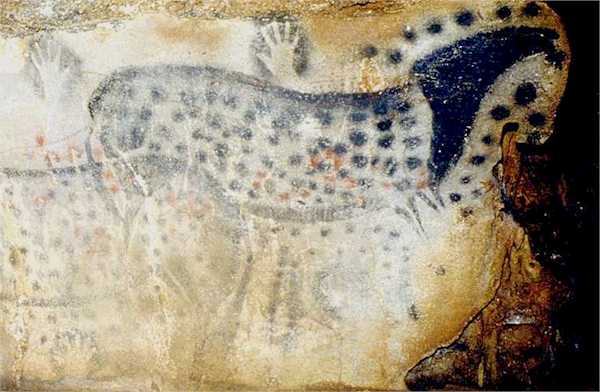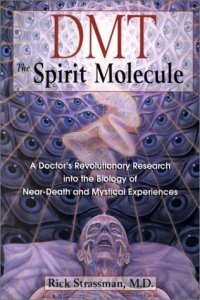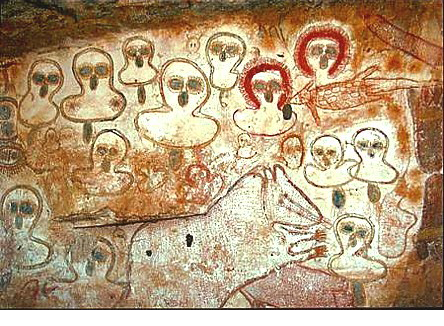Here’s an article by the Dutch artist and writer Loes Modderman, which takes a look at the Ayahuasca-inspired visions of the late Peruvian shaman Pablo Amaringo. As with everyone who partakes of this potent psychedelic brew, Amaringo was able to touch diverse metaphysical realities, and interact with entities there, several steps removed from anything in our consensual physical material world. His large body of artwork is testament to what he found within these realities. Loes ties in Amaringo’s visions and art with a discussion of plant consciousness, UFOs, out-of-the-body experiences and Charles Bonnet Syndrome. All of this this relates to the faeries and their otherworld at a deep level. When consciousness is altered from its normal state, we can experience beings that appear to have an autonomous non-physical existence, and which interact with our material reality when certain conditions are met. Sometimes they appear as faeries, sometimes not. But whatever they represent, the ontology of the entities that are regularly experienced in altered states of consciousness demands investigation and interpretation.
The article was first published by The Fairy Investigation Society. Thanks to Loes for agreeing to allow deadbutdreaming to republish it here.
‘Visions and Pablo Amaringo’ by Loes Modderman
Plant Consciousness
On the question of how the Shamans of the Amazon know that certain plants contain exactly the right chemical components to induce otherwordly visions, these shamans tell us that they know it from the plants themselves. ‘The plants tell us’ sounds crazy in the ears of Western scientists. Or used to. But the subject of plant-plant and plant-human interaction has been explored by a lot of people, in the wake of the groundbreaking 1973  book by Tompkins and Bird: The Secret Life of Plants. That plants are endowed with a particular kind of consciousness that makes them aware of us and able to respond to stimuli like attention, voices and music has been proven. They even compose their own music, as experiments in the Italian ecological community Damanhur seem to indicate. Plants also have empathy. Whoever reads the book Primary Perception (2003) written by lie- detector specialist Cleve Backster may still have a kind of guilty feeling whenever they slice a carrot or peel a potato. I have, time and again, but we have to eat, haven’t we?
book by Tompkins and Bird: The Secret Life of Plants. That plants are endowed with a particular kind of consciousness that makes them aware of us and able to respond to stimuli like attention, voices and music has been proven. They even compose their own music, as experiments in the Italian ecological community Damanhur seem to indicate. Plants also have empathy. Whoever reads the book Primary Perception (2003) written by lie- detector specialist Cleve Backster may still have a kind of guilty feeling whenever they slice a carrot or peel a potato. I have, time and again, but we have to eat, haven’t we?
In the longstanding Scottish community of Findhorn miracles happened. The barren ground in the harsh climate of north eastern Scotland was magically transformed into green gardens that yielded enormous vegetables and lots of flowers during the 1960s. Eileen Caddy (1907- 2006), one of the three people who started the community in the years after their arrival in 1962, was a clairvoyant, who talked to the plant spirits , just like the shamans of the Amazon and everywhere else in the world do. Nature spirits, caring for the plants, as is their given assignment, worked with Caddy and the results were not a question of belief, but of obvious fact. Caddy was able to see the spirits, which facilitated communication. They told her how to, and how not to. In this light the simple remark of a shaman is utterly believable: ‘the plants tell us.’
What is commonly known as ‘Ayahuasca’, a brew from a vine growing in the Amazonian rainforest, is actually made from two different plants, which supplement each other in making it work on our brains. The active substance is DMT – Dimethyltryptamine. This chemical compound differs from most other mind altering drugs: it takes the user into a different reality. And here it gets interesting, for in this reality there are elves as well as UFOs, and a lot of other real and mythical creatures. People using Ayahuasca in the forest or pure DMT in the laboratory come up with the same experience of having been somewhere outside normal space and time. Their experience is real and transformative, different from LSD or the more common psychoactive chemicals that manipulate this reality.
The Visions of Pablo Amaringo
Pablo Amaringo (1938-2009) was an ‘Ayahuasquero’, a simple Peruvian who took the brew regularly and transformed his visions into colorful paintings of exquisite beauty and multi-layered symbolism. Amaringo painted hundreds of them, and in his later years taught others. Spaceships and Faeries are intimately connected in Amaringo’s family of paintings. The first time Pablo took Ayahuasca he saw a huge UFO. Manuel, Pablo’s older brother, is a curandero, a healer. He employs mostly one special icaro – a sacred song rooted in the ‘music of Creation’ – which he learned from a faerie, named Altos Cielos Nieves.
 In 2011 an exceptional book was published, The Ayahuasca Visions of Pablo Amaringo (parenthesised numbers relate to the indexed images in this book), which sadly Amaringo never held in his hands while still being in this world. The book is a true legacy of the artist and his philosophy. Every painting is commented on and explained by Amaringo himself, and there are also several articles from Dennis McKenna, Jeremy Narby, Graham Hancock and other ‘psychonauts’ with DMT experience. Amaringo roamed many worlds. Reading through the explanations of his paintings and looking at them, one is overcome by the feeling that here is a reality more real than ours, and we ‘normal people’ are the ones living in a dream world.
The interconnectedness of everything is the central theme; the universe is alive, there are multiple dimensions, plants and animals are conscious beings, conveying deep wisdom to the shaman. Amaringo’s Ayahuasca world is populated with mythical beings, the kind we have banished to faerie-tales or religion. There are many mermaids, shapeshifting animals, talking birds and dolphins, spirits of place like the undines, salamanders and sylphs of Paracelsus or the Comte de Gabalis. There are Angels, Devas, enlightened beings and extradimensional visitors. Heavenly, as well as under water cities exist in this visionary world.
In 2011 an exceptional book was published, The Ayahuasca Visions of Pablo Amaringo (parenthesised numbers relate to the indexed images in this book), which sadly Amaringo never held in his hands while still being in this world. The book is a true legacy of the artist and his philosophy. Every painting is commented on and explained by Amaringo himself, and there are also several articles from Dennis McKenna, Jeremy Narby, Graham Hancock and other ‘psychonauts’ with DMT experience. Amaringo roamed many worlds. Reading through the explanations of his paintings and looking at them, one is overcome by the feeling that here is a reality more real than ours, and we ‘normal people’ are the ones living in a dream world.
The interconnectedness of everything is the central theme; the universe is alive, there are multiple dimensions, plants and animals are conscious beings, conveying deep wisdom to the shaman. Amaringo’s Ayahuasca world is populated with mythical beings, the kind we have banished to faerie-tales or religion. There are many mermaids, shapeshifting animals, talking birds and dolphins, spirits of place like the undines, salamanders and sylphs of Paracelsus or the Comte de Gabalis. There are Angels, Devas, enlightened beings and extradimensional visitors. Heavenly, as well as under water cities exist in this visionary world.

Essential to all life are the Icaros, according to Amaringo, being ‘the sound of the Universe – the planets, stars, comets, Everything is created by music, by vibration, by sound. Icaros is the music of creation’ (172). Here many other traditions come to mind, and one is reminded of the Music of the Spheres, an old concept, which lately came to life again with the discovery of the sounds planets and the sun make and on which even electronic compositions were based. The painter sang Icaros into the paintings when working, which, he said, ‘makes them alive and endows them with healing powers’.

As for the UFOs he painted so colourfully: ‘Extraterrestrial ships visit Earth frequently. They come from parallel universes with Sumirunas (human beings that attained mastery over land, air and water) aboard them to understand the mysterious forces of electromagnetism and gravity that maintain the cosmos’ (128). In his explanation of the painting ‘Pagoda Dorada’ (145), Amaringo says: ‘In in the corner are extraterrestrial ships carrying beings who visited primitive peoples on earth in prehistoric times, and gave them laws and spiritual teachings.’ A repeatedly painted subject is the transformative power of shamans and living things. Matter is not something static, spirit is what determines its shape. ‘You see extraterrestrial ships arriving from a celestial city to teach sumirunas and banco sumis (maestros who have attained the level of an angel) the science of the transformation of physical matter’ (147). And: ‘The Incan masters transformed themselves into machaco runas (a being with the head of a human and the body of a serpent) with ease, and in this form were able to traverse the great distances between the galaxies at the speed of thought. These great maestros developed extrasensory abilities that allowed them to explore other dimensions and celestial realms’ (147). In another painting (149) Amaringo explains: ‘Here you see the flower of toé, a plant sometimes combined with Ayahuasca to intensify your visions. With toé you can learn what a person is thinking, and it can enable you to see spirit beings as they are in their natural form. Shamans use toé to help them delve into profound mysteries. They may be assisted by extraterrestrials, coming from Mars and Jupiter, and from other galaxies (150).’

When the Shaman is in the process of healing someone from the influence of a malignant spirit, he sings the sublime sumac icaro. ‘The spirits always accept the invitation, and nymphs, dryads, faeries and hamadryads who live in the trees , and elves and sibyls all come to listen to the sumac icaro. Spirits arrive in spaceships from far away galaxies to see if someone needs them’ (151). In one painting Amaringo states: ‘There’s an extraterrestrial craft radiating a blue beam, which transmits knowledge from other dimensions’ (153). In one of the last paintings in the book, Misterio Profundo, a space ship has a central position. He explains: ‘The spaceship that has arrived from a distant galaxy brings spiritual beings to teach the sumiruna (far advanced humans), muraya (master with the ability to live under water) and banco sumi (master of wisdom, as wise as an angel) in their ceremony. They warn of the imbalance of the biosphere caused by man’s destruction of the rain forest. Through negligence, ignorance and greed, humans have prejudiced the delicate web of life on which we depend. The beings are giving shamans’ energy to heal the planet with icaros and soplos (smoke used in rituals and healing)’ (159).
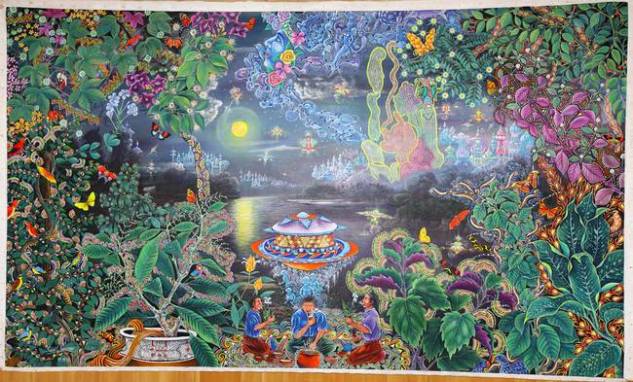
It is clear from these fragments that in the wisdom obtained by regularly drinking Ayahuasca no clear distinction is made between different realities. The idea is that multiple realities overlap and in fact fill the same space, only at different vibrational levels. Amaringo’s descriptions of what ‘extraterrestrials’ are doing in his paintings is seemingly as much part of our own abduction lore (the environmental warnings, the extraterrestrial origin on other planets) as it is of interdimensional origin, as described in the interaction with nature spirits, shamans and holy humans in an extradimensional space-time setting. Some elements also sound reminiscent of our own UFO lore: the shapeshifting abilities, the sudden appearance when being called, the ancient astronaut analogies and even the disappearances under water. Amaringo says that these vehicles may take many shapes, are able to attain infinite speed, and can travel under water or under the earth. The beings travelling in them are like spirits, having bodies more subtle than ours, appearing and disappearing at will. They belong to extraterrestrial civilizations that live in perfect harmony. Great Amerindian civilizations like the Maya, Tiahuanaco, and Inca had contact with these beings. Pablo says that he saw in his journeys with Ayahuasca that the Maya knew about this brew, and that they left for other worlds at some point in their history, but are about to return to this planet. In fact he says that some of the flying saucers seen by people today are piloted by Maya wise men. Just wondering: could the amazing frequency of UFOs seen in the heavens and on the grounds of the Latin American continent have any connection with their being ‘called’ and contacted by Ayahuasquero and shamans? Or do otherworldly beliefs and practice like those of the Candomblé and Umbanda religions in Brazil have any influence? If UFOs really are (sometimes) liminal objects, between ‘real’ and psychic, this could be a possibility.

Ayahuasca, OBEs, Faeries and DMT
Ayahuasca doesn’t yield its wonder-world easily. One has to grow into the experience and in this it is no different from moving to another country: one has to learn and adjust before one can easily find the way. What makes the Ayahuasca different from other drugs is that in time one encounters beings that seem to be aware of you being there. They react, and talk to you. There is interaction. How strange is that? No more strange than what Ingo Swann, the late psychic and Remote Viewer encountered when he visited the dark side of the Moon. He saw beings there, buildings, saucers, and they saw him too (Penetration, 1998). Imagine the power of the human mind, which allows us to project our consciousness over enormous distances and take an astral shape that can be seen, and talked to. Ingo Swann didn’t let that happen, he was simply afraid and left. What’s the difference between inner and outer space when Remote Viewing as well as Ayahuasca allows the psychonaut to have a conversation with beings from other worlds or other dimensions, while physically sitting in his easy chair? The late Terrence McKenna in True Hallucinations (1993) wrote: ‘A UFO is essentially this hyperspatially mobile psychic vortex, and the trip may well involve contact with some race of hyperspatial dwellers. Perhaps it will be an encounter similar to a ‘flying lesson’: instruction in the use of the transdimensional stone, how to navigate in hyperspace, and perhaps an introductory course in Cosmic Ecology tending.’
 People having Out of Body Experiences are doing the same thing, and some of them mention encounters with other OBE-ers, or frightening encounters with less agreeable astral beings. Probably the air around us is alive with astral junk, and not being able to see them is a gift. ‘Only with DMT do people meet up with them, with other beings in a nonmaterial world’, writes Rick Strassman in his book DMT – The Spirit Molecule (2001). No other drug has this effect. From 1990 till 1995 Rick Strassman carried out government sanctioned research at the University of New Mexico (normally DMT is a scheduled drug) with 60 volunteers, by injecting them with various doses of pure DMT. Karl, a 45 year old blacksmith, described his experience: ‘This was real strange. There were a lot of elves. They were prankish.(…) They commanded the scene, it was their terrain! They were about my height. (…) one of them made it impossible for me to move. There was no issue of control; they were totally in control. (…) I heard a giggling sound – the elves laughing or talking at high speed volume, chattering, twittering’.
People having Out of Body Experiences are doing the same thing, and some of them mention encounters with other OBE-ers, or frightening encounters with less agreeable astral beings. Probably the air around us is alive with astral junk, and not being able to see them is a gift. ‘Only with DMT do people meet up with them, with other beings in a nonmaterial world’, writes Rick Strassman in his book DMT – The Spirit Molecule (2001). No other drug has this effect. From 1990 till 1995 Rick Strassman carried out government sanctioned research at the University of New Mexico (normally DMT is a scheduled drug) with 60 volunteers, by injecting them with various doses of pure DMT. Karl, a 45 year old blacksmith, described his experience: ‘This was real strange. There were a lot of elves. They were prankish.(…) They commanded the scene, it was their terrain! They were about my height. (…) one of them made it impossible for me to move. There was no issue of control; they were totally in control. (…) I heard a giggling sound – the elves laughing or talking at high speed volume, chattering, twittering’.
Elves were met by Terrence McKenna too, on his regular DMT trips. He calls them ‘machine elves’. Some of them, seen by him and others, wear pointed hats and green elf- garb and are around one metre in height. Aaron, another of Strassman’s guinea pigs gave the following description: ‘An insectlike thing got right into my face, hovering over me as the drug was going in. This thing sucked me out of my head into outer space. It was clearly outer space, a black sky with millions of stars.’ In the next experiment Aaron felt helpless and being watched by reptilians. This all sounds very much like an alien abduction scenario, only nobody was abducted – not in the flesh, anyway. A guy named Lucas said: ‘There was a space station below me and to my right. There were at least two presences, one on either side of me, guiding me to a platform. I was aware of many entities inside the space station – automatons, androidlike creatures, except that they were living creatures, not robots.’. Experiences get increasingly strange and the whole hodgepodge of beings from faerie folklore and abduction scenarios are encountered. But if there are many dimensions, there is no reason to assume that every user of DMT end up in the same dimension. Some experiences are good and warm, others are extremely frightening, but all are absurdly weird. For almost every person who participates, these experiences are among the most impressive and unforgettable of their whole lives.
 Jacques Vallée has done pioneering work in Passport to Magonia (1969), in which he explores the many similarities between folklore and Ufology. He was the first to study this subject scientifically, though not the first to pay attention to the phenomena in this way. Many followed, among them the Fortean writers John Keel and Jerome Clark. I’m not going into Vallée now, everyone should read this book. Vallée never mentioned DMT though. In the light of the DMT related visions we can safely assume that the world of spirits and elementals, and the world of UFOs are somehow connected by inter-dimensional strings. How, we don’t know. Maybe all dimensions are endowed with the same ‘magic’ and the same characteristics. Something really fascinating is going on.
Jacques Vallée has done pioneering work in Passport to Magonia (1969), in which he explores the many similarities between folklore and Ufology. He was the first to study this subject scientifically, though not the first to pay attention to the phenomena in this way. Many followed, among them the Fortean writers John Keel and Jerome Clark. I’m not going into Vallée now, everyone should read this book. Vallée never mentioned DMT though. In the light of the DMT related visions we can safely assume that the world of spirits and elementals, and the world of UFOs are somehow connected by inter-dimensional strings. How, we don’t know. Maybe all dimensions are endowed with the same ‘magic’ and the same characteristics. Something really fascinating is going on.
A Postscript – Charles Bonnet Syndrome
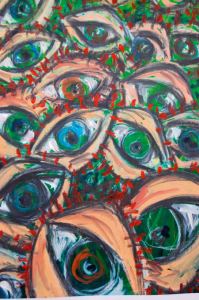
People with a form of macular degeneration, known as ‘Charles Bonnet Syndrome’ lose sight at the centre of their vision. But in some cases that is not all that happens. Some of them, maybe many, start hallucinating. They see all kinds of beings parading through their rooms and in the street. Some are ‘extra’ people or animals, others are characters that seem to be out of faerie folklore. Ophthalmologists are quick to point out that this is one of many tricks our brains play on us, when there is lack of visual stimulants. Our minds tend to fill in the blanks. Oh, is that so? I always have the feeling that some scientists can’t think straight, because of all the eye woes that people suffer – cataract, inherited bad eyes, you name it – Charles Bonnet Syndrome is the only one where the brains seem to produce ‘replacement’ stimuli in this particular way. Strangely enough, this theory is the accepted one. Clifford Pickover, who talks about Charles Bonnet Syndrome extensively in his book Sex, Drugs, Einstein & Elves (2005) compares the Bonnet experience with DMT visions. Elves, strange midgets with pointed heads, angels, ghostly figures, aliens, floating processions of the damned parade where they should not be. Small wonder that the sufferer thinks he is raving mad, and is reluctant to mention his visions to his family. DMT is a substance that naturally occurs in our brains: it makes you wonder why it is forbidden in many countries! Just a thought: could it be that the brains of people with Charles Bonnet Syndrome are somehow opening up, or producing more of the chemical for some unknown reason, rending the veil between dimensions? Are there always, in every Charles Bonnet patient, the same sort of visions? Somehow these visions are triggered. Somehow these visions must be real, somewhere. Maybe these people are compensated in a very unusual way for the partial loss of sight.
***
The cover image is ‘Sumac Ňusta’ by Pablo Amaringo. He describes her thus: Sumak Ňusta – Hermosa Doncella. She is a faerie from the Aquarius constellation and she stands in front of a celestial temple inspiring love, beauty, and gentleness. In her hand she holds a jar of aromatic balsam, and flowing from this are iridescent waves that transmit the sublime fragrance of flowers. She is a specialist in the extraction and distillation of balsams, scents, and incenses from flowering plants found only on earth. Her delightful perfumes are a source of joy and contentment for these extraterrestrial beings.
Loes’ artwork can be found at her website here. She also has a blogsite ParaVaria. Prints of Pablo Amaringo’s original artwork can be viewed and purchased here.
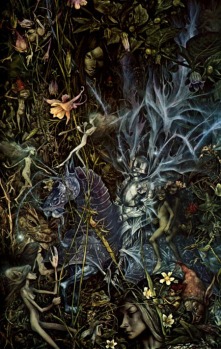
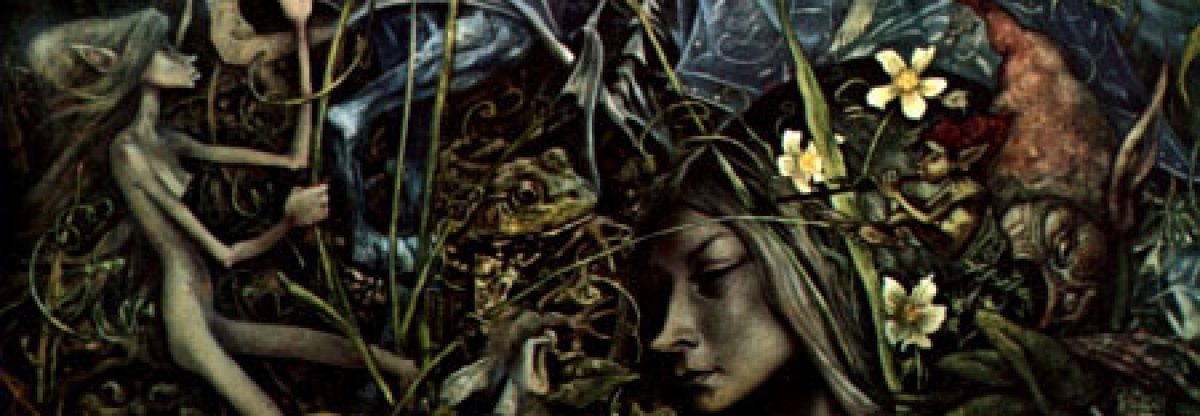


 Trevor-Roper and other historians, it was only the attitudes of these cultural elites that could be discerned from the documentation. The actual recorded beliefs of the accused witches were simply ‘disturbances of a psychotic nature’, ‘fantasies of mountain peasants’, and ‘mental rubbish of peasant credulity and feminine hysteria.’ In other words, any suggestion that the phenomenon the accused witches were recorded as describing might have elements of truth to it was baloney. But Wilby, following the lead of
Trevor-Roper and other historians, it was only the attitudes of these cultural elites that could be discerned from the documentation. The actual recorded beliefs of the accused witches were simply ‘disturbances of a psychotic nature’, ‘fantasies of mountain peasants’, and ‘mental rubbish of peasant credulity and feminine hysteria.’ In other words, any suggestion that the phenomenon the accused witches were recorded as describing might have elements of truth to it was baloney. But Wilby, following the lead of 
 animals that could fit the bill as familiars, they could be mice, cats, dogs, birds, insects, horses, bears, foxes, frogs, even hedgehogs, though the most popular were goats – witches riding astride goats were commonly portrayed in medieval and Early Modern illustrations, and even in architectural reliefs, such as at Lyons Cathedral, where a witch is shown riding a goat and holding a hare (shown above).
animals that could fit the bill as familiars, they could be mice, cats, dogs, birds, insects, horses, bears, foxes, frogs, even hedgehogs, though the most popular were goats – witches riding astride goats were commonly portrayed in medieval and Early Modern illustrations, and even in architectural reliefs, such as at Lyons Cathedral, where a witch is shown riding a goat and holding a hare (shown above).

 by the late 16th century this was being rectified, and even King James VI of Scotland (later James I of a united kingdom with England) himself felt compelled to write
by the late 16th century this was being rectified, and even King James VI of Scotland (later James I of a united kingdom with England) himself felt compelled to write  Isobel and her fellow accused witches also confessed to combining the use of faerie familiars with zoomorphism to attain their goals, which were sometimes beneficent, and sometimes maleficent. Whatever the objectives of these Scottish witches, their testimonies confirm their belief that in order to interact with a faerie otherworld they were reliant on the aid of familiars, or on their ability to turn themselves into animals. Isobel Gowdie again:
Isobel and her fellow accused witches also confessed to combining the use of faerie familiars with zoomorphism to attain their goals, which were sometimes beneficent, and sometimes maleficent. Whatever the objectives of these Scottish witches, their testimonies confirm their belief that in order to interact with a faerie otherworld they were reliant on the aid of familiars, or on their ability to turn themselves into animals. Isobel Gowdie again: A decade later, and under more intimidatory cross-examination, the Northumberland witch Anne Armstrong claimed that she was commanded to sing whilst her companion witches: ‘danced in several shapes, first of a hare, then of their own, then in a cat, sometimes a mouse, and several other shapes.’
A decade later, and under more intimidatory cross-examination, the Northumberland witch Anne Armstrong claimed that she was commanded to sing whilst her companion witches: ‘danced in several shapes, first of a hare, then of their own, then in a cat, sometimes a mouse, and several other shapes.’ What is described as happening to the people involved in witchcraft in these periods, bears many of the hallmarks of shamanistic practice. Shamanism is not an organised religion, it is rather a technique for direct contact with a metaphysical, spiritual reality through the arbitration of individuals able to reach that reality by altering their states of consciousness. This contact with a spiritual, non-physical realm was/is usually conducted to bring back information from that realm, that is deemed useful, such as healing,
What is described as happening to the people involved in witchcraft in these periods, bears many of the hallmarks of shamanistic practice. Shamanism is not an organised religion, it is rather a technique for direct contact with a metaphysical, spiritual reality through the arbitration of individuals able to reach that reality by altering their states of consciousness. This contact with a spiritual, non-physical realm was/is usually conducted to bring back information from that realm, that is deemed useful, such as healing,
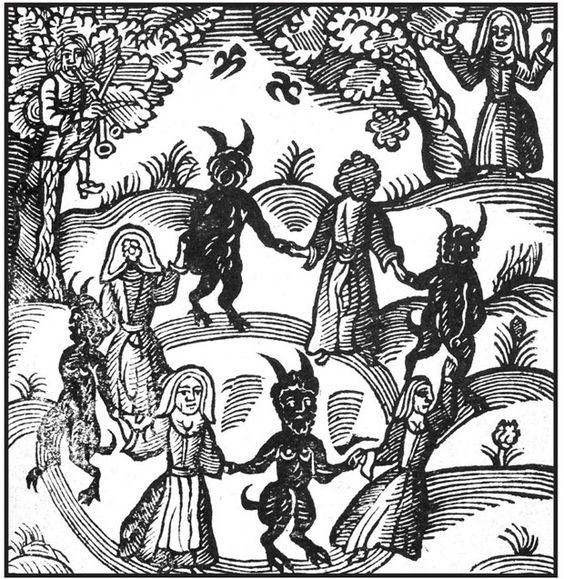


 wrote extensively about the folklore of the faeries, including
wrote extensively about the folklore of the faeries, including 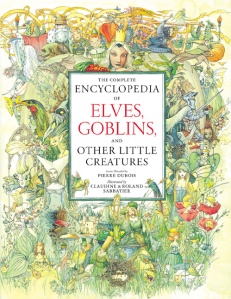 Dubois (1992). Dubois has a very playful style of writing that matches the subject matter perfectly, and he covers an extraordinary range of faerie types from around the world, co-ordinated into sections that describe each entity alongside an illustrative story. The description usually includes the ‘behaviour’ of the faerie in question. Typical of Dubois’ tone is this entry for the behaviour of The Mimi, supernatural entities of the aboriginal Australians…
Dubois (1992). Dubois has a very playful style of writing that matches the subject matter perfectly, and he covers an extraordinary range of faerie types from around the world, co-ordinated into sections that describe each entity alongside an illustrative story. The description usually includes the ‘behaviour’ of the faerie in question. Typical of Dubois’ tone is this entry for the behaviour of The Mimi, supernatural entities of the aboriginal Australians…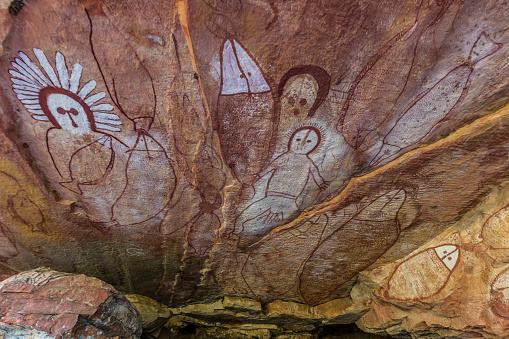
 (1848-1927) whose
(1848-1927) whose  he collected stories and anecdotes about the faeries from the rural populations. His language can occasionally seem archaic and quaint, but there is no doubt that he imbued himself in the Celtic communities that he spent time with during his years of travels amongst them. He had the time, that a modern anthropologist/folklorist could only dream of, to visit these communities and spend time with them, soaking up their stories and anecdotes, which revealed so much about the deeply ingrained belief in the faeries and the way these entities interacted with consensual reality. In doing so, he gained a great admiration for the rural people he came across, who would tell it like it was.
he collected stories and anecdotes about the faeries from the rural populations. His language can occasionally seem archaic and quaint, but there is no doubt that he imbued himself in the Celtic communities that he spent time with during his years of travels amongst them. He had the time, that a modern anthropologist/folklorist could only dream of, to visit these communities and spend time with them, soaking up their stories and anecdotes, which revealed so much about the deeply ingrained belief in the faeries and the way these entities interacted with consensual reality. In doing so, he gained a great admiration for the rural people he came across, who would tell it like it was.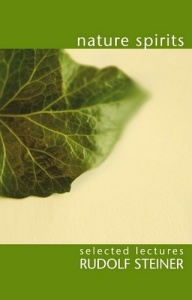 spiritual philosopher Rudolf Steiner, who, in a series of lectures between 1908 and 1924, outlined his concept of
spiritual philosopher Rudolf Steiner, who, in a series of lectures between 1908 and 1924, outlined his concept of  concept further in his book
concept further in his book  until 2014) is Marjorie Johnson’s
until 2014) is Marjorie Johnson’s  Perhaps that should be Victorian re-invention. The best overview of what happened to the faeries in popular consciousness during the 19th century is Carole Silver’s
Perhaps that should be Victorian re-invention. The best overview of what happened to the faeries in popular consciousness during the 19th century is Carole Silver’s 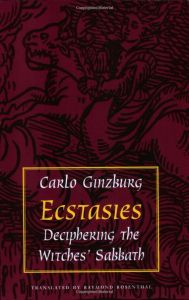 witches’ sabbath in the medieval and Early Modern periods, Ginzburg recognises the essential role the faeries play in accounts of the sabbath. His use of historical sources to recreate what was really going on at the sabbaths is deeply impressive, and he has single-handedly overturned previous cultural historical theses, that the sabbath was simply an imaginary construct of the ecclesiastic and secular elites to close down on perceived heretics and maintain control over subversive groups. The sabbaths were real, and Ginzburg goes into detail as to how and why the faeries were included in these sacred rituals, facilitating ‘ecstasies’ and accompanying the witches on their metaphysical journeys. This eventually brings us to Ginzburg’s main hypothesis, that the sabbath was a survival of Eurasian prehistoric shamanism. The ‘ecstasies’ were brought about through group altered states of consciousness that enabled the witches to partake in a metaphysical reality for magical purposes… they were travelling to the otherworld, accompanied by their faerie familiars, just as Eurasian shamans had done. Ginzburg convincingly argues the case for continuity from prehistoric shaman to medieval/Early Modern witch.
witches’ sabbath in the medieval and Early Modern periods, Ginzburg recognises the essential role the faeries play in accounts of the sabbath. His use of historical sources to recreate what was really going on at the sabbaths is deeply impressive, and he has single-handedly overturned previous cultural historical theses, that the sabbath was simply an imaginary construct of the ecclesiastic and secular elites to close down on perceived heretics and maintain control over subversive groups. The sabbaths were real, and Ginzburg goes into detail as to how and why the faeries were included in these sacred rituals, facilitating ‘ecstasies’ and accompanying the witches on their metaphysical journeys. This eventually brings us to Ginzburg’s main hypothesis, that the sabbath was a survival of Eurasian prehistoric shamanism. The ‘ecstasies’ were brought about through group altered states of consciousness that enabled the witches to partake in a metaphysical reality for magical purposes… they were travelling to the otherworld, accompanied by their faerie familiars, just as Eurasian shamans had done. Ginzburg convincingly argues the case for continuity from prehistoric shaman to medieval/Early Modern witch.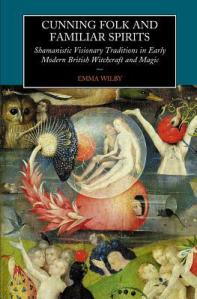 In her compelling 2005 book
In her compelling 2005 book  shamanistic tradition. In his 2005 book
shamanistic tradition. In his 2005 book  Magonia
Magonia Serena Roney-Dougal takes this theme of the faeries as external agents of interference in human culture and runs with it in her 2002 book
Serena Roney-Dougal takes this theme of the faeries as external agents of interference in human culture and runs with it in her 2002 book 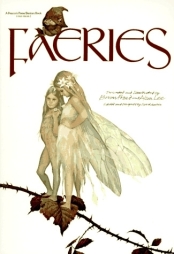 and Alan Lee. This is a playful, illustrative romp through faerie-lore, based on the descriptions given by Katherine Briggs in her Encyclopedia of Fairies. Froud and Lee capture the essence of folkloric faeries in their intense and atmospheric images of faeries from Britain and Ireland, always with the prescribed conviction that they are acting on ‘inside information’. There are no gossamer-winged faeries here… they’re real and vital, and the consistent republications of the volume prove the popularity of their vision. Take a look at any website about the faeries, and you’ll find some of their illustrations there. It probably ranks as the bestselling faerie book ever.
and Alan Lee. This is a playful, illustrative romp through faerie-lore, based on the descriptions given by Katherine Briggs in her Encyclopedia of Fairies. Froud and Lee capture the essence of folkloric faeries in their intense and atmospheric images of faeries from Britain and Ireland, always with the prescribed conviction that they are acting on ‘inside information’. There are no gossamer-winged faeries here… they’re real and vital, and the consistent republications of the volume prove the popularity of their vision. Take a look at any website about the faeries, and you’ll find some of their illustrations there. It probably ranks as the bestselling faerie book ever.
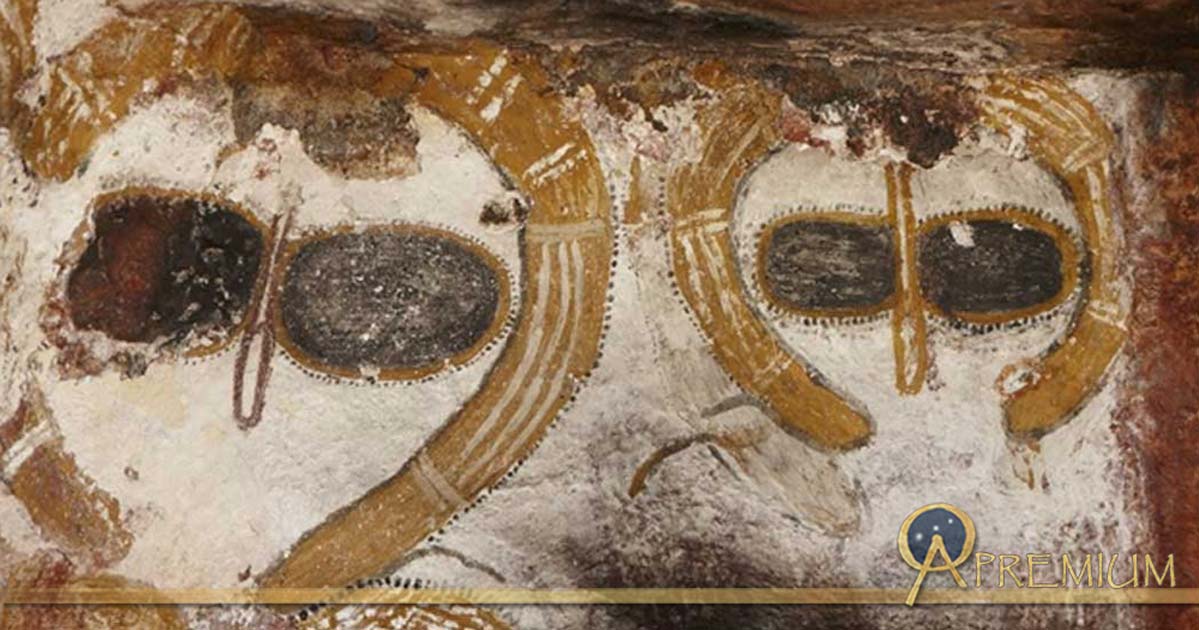
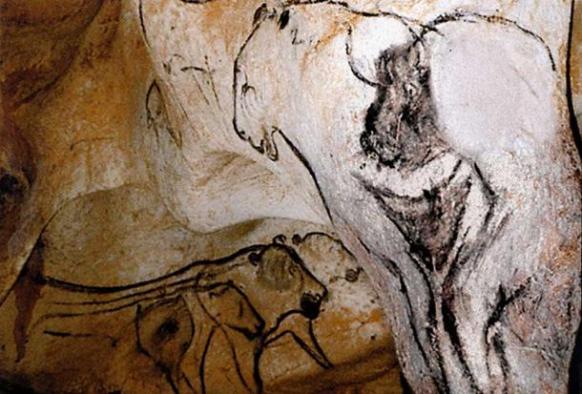



 His hypothesis is that there is a commonality to the experiences reported in alien abduction scenarios, and the reports of interactions with faeries in folklore. He suggests the aliens and the faeries are essentially the same phenomenon, tuned through the cultural receptors of the time and then interpreted accordingly. He makes special reference to the regular motifs in faerie-tales of the abduction, by various means, of humans by faeries. There’s a lot of data here – it’s the commonest motif in faerie folklore. For a variety of reasons humans are taken to faerieland in the stories, either as midwives or nurses for faerie children, as servants to the faeries, for sex, as punishment or reward, or just because the faeries feel like it. They were also keen on abducting babies, and replacing them with changelings; wizened old faerie creatures who would usually die before the end of the story if a ruse to return the human baby wasn’t discovered. These motifs, of course, coincide with many aspects of the monumentally strange phenomenon of alien abductions, reports of which have grown at an exponential rate since the early 1950s. Vallee uses a range of evidence to tie-up faerie abductions from folklore and alien abductions from modern reports, and goes as far to state:
His hypothesis is that there is a commonality to the experiences reported in alien abduction scenarios, and the reports of interactions with faeries in folklore. He suggests the aliens and the faeries are essentially the same phenomenon, tuned through the cultural receptors of the time and then interpreted accordingly. He makes special reference to the regular motifs in faerie-tales of the abduction, by various means, of humans by faeries. There’s a lot of data here – it’s the commonest motif in faerie folklore. For a variety of reasons humans are taken to faerieland in the stories, either as midwives or nurses for faerie children, as servants to the faeries, for sex, as punishment or reward, or just because the faeries feel like it. They were also keen on abducting babies, and replacing them with changelings; wizened old faerie creatures who would usually die before the end of the story if a ruse to return the human baby wasn’t discovered. These motifs, of course, coincide with many aspects of the monumentally strange phenomenon of alien abductions, reports of which have grown at an exponential rate since the early 1950s. Vallee uses a range of evidence to tie-up faerie abductions from folklore and alien abductions from modern reports, and goes as far to state:

